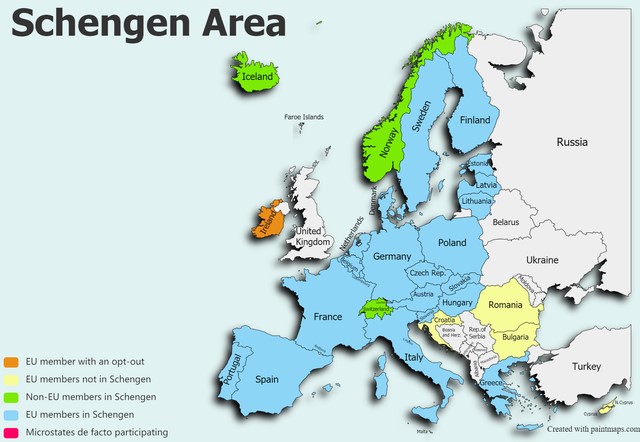
Do Not Waste Your Student Schengen Visa
My host daughter is attending graduate school in France. This means she has a student Shengen visa that allows her to travel and see other parts of Europe. When I heard that she wasn’t taking advantage of it, I told her she needs to get moving!
So, what is a Student Schengen Visa:
A student Schengen Visa is an entry permit to the Schengen region of Europe. This visa is granted to third-country nationals who study in any of the member states. The Schengen Region is made up of 26 countries: Austria, Belgium, the Czech Republic, Denmark, Estonia, Finland, France, Germany, Greece, Hungary, Iceland, Italy, Latvia, Liechtenstein, Lithuania, Luxembourg, Malta, the Netherlands, Norway, Poland, Portugal, Slovakia, Slovenia, Spain, Sweden and Switzerland.

What Can Your Student Schengen Visa Do for You?
Especially in the time of COVID, everyone was hesitant to travel and explore. But with a Student Schengen Visa traveling within the region is often just a train ride away. My advice is mask up, use your sanitizer, wash your hands frequently and go see the world! Concern for COVID while traveling really depends. Where are you leaving from? What is the virus rate at your destination? Are you fully vaccinated? Do you have plans in case you have to quarantine?
Make Sure You Are Fully Vaccinated Before You Travel
One of the best pieces of advice are to be vaccinated. This can help save time and money when it comes to entering countries with COVID testing restrictions. And even if you are fully vaccinated, try to choose activities outdoors or where you can socially distance. Always try to wash your hands before eating anything. And test yourself before you travel and after your return. With these I think travel can be done safely.

I told my host daughter to open her mind. Try visiting Spain and go to Restaurante Mandela 100 in Madrid and eat authentic Senegalese Food. Find the best pizza in Rome or people watch at Trafalgar Square in London.
How to Start Planning
1. Google is your friend when it comes to finding information on where to go, what to do, and where to eat on a budget (cheap eats).
2. My number one tip: Use the google flights map to find destinations based on your travel dates and trip fares. My favorite flight search engines are google flights or momondo to help you find cheap flights.
3. Once you find a cheap flight or for the dates you want now the fun begins to customize your trip in the Schengen region!
Flights Are Booked, What’s Next?
Next thing you want to do is search for accommodation. If you’re on a budget there are plenty of options out there for you. I love staying in hostels when I’m travelling. Its inexpensive, fun, and a more social environment than an Airbnb or hotel would be. Be sure to check out my blog about what a hostel is if you want to know more! I often use Hostel World.com and find a centrally located hostel that’s highly rated.
Making a list of places you want to visit. Looking up free things to do in the city you’re visiting. Then find out the cost of fees to enter museums, cultural attractions and other tourist areas on your list. Be sure to see if there any festivals or activities while you’re visiting.
For a weekend trip if the train takes more than a few hours, it might be better to look at airfares and compare prices for the better deal!
Check Prices and flights on Budget Airlines
4. Be ready to travel on one of many cheap/budget airlines in Europe. Travel based on the dates when the flights are cheap. Here are a few of the top budge airlines in Europe, but there are many more.
EasyJet.
Ryanair
Eurowings
Norwegian
Jet2.com
Wizz Air
Getting Around Your Destination City
So, you’ve arrived in your Schengen area country. Its very tempting to try and grab an uber straight to your accommodation. Be aware that uber may not be widely available in the country your visiting. Also Uber rides will add up over time, even on a short weekend trip. My advice is to see if your city has a discount all day pass for the metro, bus, and rail system.
For example, when visiting Lisbon, Portugal there is a Viva Viagem Zapping Card. The Viva card can be bought in country at ticket vending machines and ticket offices. It is good for 24 hours and costs €5 for unlimited rides on their rail, bus, and metro system.
Quick Tips for Schengen Region Travel
- Only take a small bag or backpack. Do not overpack for a weekend getaway. Keep it simple.
- Wear comfortable shoes.
- Dress for the weather!
- Make sure you stay at a hostel that serves free breakfast.
- If possible, socialize and hangout with others in your hostel. Meet new people and join in on the activities at your hostel.
- Check COVID19 regulations for entering your destination country. Are the border open to visitors and tourists?

Here is my sample budget of a full 2-Days in Lisbon
$35 Flight on Ryanair – London, UK to Lisbon, Portugal
$50 Two nights in the Sunset Destination Hostel – located right in the train station
$15 Two full days of Viva Viagem Metro Card (added about $5 for the Ferry)
$15 Visit the Sintra Castles
$0 Funicular Trolley Tour around city
$0 Walking Tour & visit the Mercado da Ribeira (Time Out Market)
$5 Pastéis de Nata – famous Portuguese Pastries
$10 Snack for Lunch
$15 Dinner
$30 Miscellaneous
$175 total for two full days and one overnight in Lisbon, Portugal (including my airfare and lodging). If you plan enough ahead of time your airfare and accommodation maybe even cheaper!
Tip: Wake up early on departure day to your destination – you don’t want to rush or miss your flight!
- Relax after arriving in your city, but plan a full second day.
- Eat a good breakfast at your hostel and be on schedule for your full day.
- When you get back home, plan your next Schengen region getaway.
Having a student Schengen visa will allow you to see the world of Europe easily. Taste great food, wonderful history, and have fun while you are a studying, don’t pass up the opportunity!




Leave a Reply